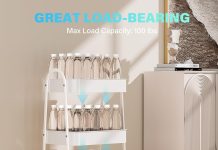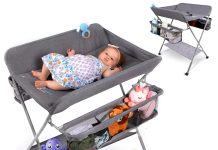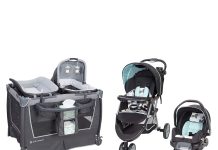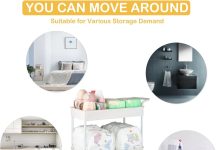Having a baby is an exciting and joyous time, but it also comes with countless responsibilities and the need to ensure their safety at all times. One crucial area that requires our attention is the changing table. As parents, we want to create a safe and secure environment where we can comfortably change our little one’s diapers without any worries. So, how can we baby-proof the changing table area to provide the utmost protection for our precious bundle of joy? Let’s explore some practical and effective solutions in this article.
Review contents
Choosing a Safe Changing Table
When it comes to selecting a safe changing table, there are a few key factors to consider. First and foremost, it’s important to choose a sturdy changing table that can safely support the weight of your baby. Look for tables made of solid and durable materials, such as solid wood or metal frames. Avoid tables that feel wobbly or unstable.
Another important feature to look for in a changing table is safety rails. These rails provide an extra layer of security by preventing your baby from rolling off the table. Make sure the rails are sturdy and firmly attached to the table to ensure your baby’s safety.
In addition to safety rails, rounded edges are another important consideration. Sharp corners and edges can pose a risk of injury, so opt for a changing table with rounded edges. This will help prevent accidental bumps or cuts during diaper changes.
Lastly, it’s crucial to check for certification standards when choosing a changing table. Look for tables that meet safety standards and have been certified by reputable organizations. This ensures that the table has undergone rigorous testing and meets the necessary requirements for baby safety.
Securing the Changing Table
Once you’ve chosen a safe and sturdy changing table, it’s important to take steps to secure it properly. This will help prevent accidents and ensure your baby’s safety during diaper changes.
One of the first and most important steps is to anchor the changing table to the wall. This will prevent the table from tipping over if your baby leans or pushes against it. Use wall anchors or brackets to securely attach the changing table to the wall. Follow the manufacturer’s instructions for proper installation.
To further protect your baby from any sharp edges, consider using corner guards. These soft, cushioned protectors can be easily attached to the corners of the changing table, creating a safer environment for your little one.
Placing non-slip mats under the table is another important precautionary measure. These mats prevent the table from sliding or moving on smooth surfaces, reducing the risk of accidents during diaper changes.
Additionally, using a safety strap can provide an extra level of security. A safety strap can be used to secure your baby onto the changing table, preventing them from rolling or falling off. Make sure to buckle the strap tightly, but not too tightly, to ensure your baby’s comfort and safety.
Organizing Changing Supplies
When it comes to organizing changing supplies, safety should be your top priority. Here are some tips to help you keep your baby’s changing area organized and hazard-free:
First and foremost, it’s essential to keep dangerous objects out of your baby’s reach. This includes any sharp objects, chemicals, or small items that pose a choking hazard. Store these items in locked cabinets or high shelves, far away from your baby’s reach.
Consider using drawer locks or latches to prevent your baby from accessing drawers that contain potentially hazardous items. These locks can help keep your baby safe by ensuring they can’t open drawers and come into contact with dangerous objects.
To make diaper changes more convenient, store diapering essentials within arm’s reach. Place diapers, wipes, cream, and any other necessary items in a designated area near the changing table. This will make it easier for you to access everything you need without having to leave your baby unattended.
Arranging items in a labeled storage system can help you stay organized and ensure that everything is easily accessible. Use baskets, bins, or drawer dividers to keep different items separate and labeled. This will save you time and make diaper changes more efficient.
Eliminating Hazards
A safe changing area requires eliminating potential hazards that could harm your baby. Here are some essential precautions to take:
Covering electrical outlets is an important step in baby-proofing the changing table area. Use outlet covers or safety plugs to block access to electrical outlets. This will prevent your baby from accidentally touching exposed wires or sticking objects into the outlets.
Remove any cords or wires hanging near the changing table. Cords can pose a strangulation hazard, so it’s important to keep them out of your baby’s reach. Secure cords with cord shorteners or cord clips to prevent accidents.
Ensure the area is well-lit to avoid any accidents or mishaps during diaper changes. Install a bright overhead light or use portable, battery-operated lights to provide adequate lighting. This will help you see clearly and ensure your baby’s safety.
Keep small objects, such as toys or loose buttons, away from your baby’s reach. These items can pose a choking hazard if your baby accidentally puts them in their mouth. Regularly inspect the changing area and remove any small objects that may have been left behind.
Safe Diaper Changing Practices
Practicing safe diaper changing techniques is crucial for your baby’s well-being. Here are some important guidelines to follow:
Always keep a hand on your baby during diaper changes. This ensures that your baby stays safe and prevents accidental falls or injuries. Keep one hand on your baby at all times, even if you need to reach for something nearby.
Secure the diaper changing pad firmly on the changing table. The pad should be securely attached or have straps that can be fastened to the table. This prevents the pad from shifting or sliding during diaper changes, reducing the risk of falls.
Avoid distractions during changing time. It’s important to give your full attention to your baby during diaper changes to ensure their safety. Put away your phone, turn off the television, and focus solely on your baby.
Dispose of soiled diapers properly. Use a designated diaper pail with a sealing lid to keep odors contained and prevent your baby from accessing dirty diapers. Empty the diaper pail regularly to maintain a clean and hygienic changing area.
Maintaining a Clean Changing Area
Maintaining cleanliness in the changing area is essential for your baby’s health and well-being. Follow these tips to keep the changing area clean:
Regularly disinfect the changing table to keep it free from germs and bacteria. Use a mild disinfectant or baby-safe wipes to clean the surface of the table. Wipe down all areas, including the safety rails and any storage compartments.
Use washable or disposable changing pad covers to maintain cleanliness and hygiene. These covers provide an extra layer of protection for the changing pad and can be easily washed or replaced when soiled.
Keep wipes and sanitizers nearby for convenient clean-up during diaper changes. Having these items within reach will allow you to quickly clean your baby’s bottom and sanitize your hands as needed. Ensure that the wipes and sanitizers are stored in a secure and easily accessible location.
Maintain good hand hygiene by washing your hands before and after every diaper change. Use warm water and soap to thoroughly clean your hands for at least 20 seconds. This helps prevent the spread of germs and bacteria.
Creating a Comfortable Environment
Creating a comfortable environment for your baby can make diaper changes a more pleasant experience. Consider the following tips to ensure your baby feels cozy and relaxed during diaper changes:
Ensure proper room temperature in the changing area. Keep the room at a comfortable temperature to prevent your baby from feeling too hot or too cold during diaper changes. Use a thermometer to monitor the room temperature and adjust accordingly.
Use a comfy changing pad to provide cushioning and support for your baby. Look for a pad with a soft and waterproof cover that can be easily wiped clean. This will keep your baby comfortable and make diaper changes more enjoyable for both of you.
Keep distractions to a minimum during diaper changes. Choose a quiet and calm area for diaper changes to prevent your baby from becoming too stimulated. Avoid loud noises or bright lights that could disrupt their focus.
Provide soothing background sounds, such as soft music or white noise, to create a relaxing atmosphere during diaper changes. This can help calm your baby and make the experience more enjoyable for them.
Preventing Falls and Injuries
Preventing falls and injuries should be a top priority when it comes to your baby’s safety during diaper changes. Here are some important steps to take:
Never leave your baby unattended on the changing table. Even if you need to step away for a moment, always take your baby with you or have someone watch over them. Leaving your baby unattended, even for a brief moment, can result in serious accidents.
Use safety rails or barriers on the changing table to prevent your baby from rolling or falling off. Make sure the rails are securely attached and tall enough to provide adequate protection. Regularly check the rails for any loose or broken parts and repair or replace them as needed.
Avoid stacking items, such as diapers or toys, near the changing table. Stacked objects can easily fall and potentially harm your baby. Keep the changing area clear of any clutter and ensure that items are stored securely.
Be cautious while lifting or reaching for items during diaper changes. Use proper lifting techniques to avoid strain or injury to yourself. Reach for items that are within your arm’s reach to prevent accidents or falls.
Regularly Inspecting the Changing Area
Regular inspections of the changing area are essential to ensure that it remains safe and hazard-free. Here’s what you should do:
Check for loose parts or screws on the changing table. Regularly inspect the table for any loose or wobbly parts. Tighten any screws or bolts that may have come loose to ensure the stability of the table.
Replace any worn-out or damaged items in the changing area. This includes changing pads, safety straps, or any other accessories that are showing signs of wear and tear. Replace these items promptly to maintain a safe and secure changing area.
Ensure proper alignment of safety features, such as safety rails or barriers. Check that the safety rails are properly aligned and securely attached to the changing table. If any adjustments or repairs are needed, take immediate action to fix them.
Inspect the changing pad for tears or cracks. A torn or cracked changing pad can be a safety hazard. Regularly check the pad for any signs of damage and replace it if necessary. A clean and intact changing pad is crucial for your baby’s safety and comfort.
Promoting Childproofing Awareness
Promoting childproofing awareness is essential for the safety of all babies and young children. Spread awareness and encourage safe practices in the changing table area with these steps:
Educate yourself and others about the importance of baby-proofing the changing area. Stay informed about the potential hazards and risks involved in diaper changes and share this knowledge with others. The more people are aware, the safer our children will be.
Encourage safe practices among parents and caregivers. Stress the importance of always keeping a hand on the baby during diaper changes, securing the changing table, and practicing proper hygiene. Remind others to be vigilant and proactive in ensuring their baby’s safety.
Share information on baby-proofing with fellow parents and caregivers. Use social media, parenting forums, or playgroup gatherings to raise awareness about the importance of baby-proofing the changing table area. Share tips, resources, and personal experiences to help others create a safe environment for their babies.
Consider consultation with a professional if you are unsure about the safety of your changing area. An expert in childproofing can assess your changing area, identify potential hazards, and provide personalized recommendations to make it safer. Their expertise and guidance can give you peace of mind and help create a secure environment for your baby.
By following these comprehensive guidelines, you can ensure that your baby’s changing area is safe and secure. Remember, the safety of your baby should always be your top priority, and taking the necessary precautions will help prevent accidents and injuries during diaper changes.






























